#fall moose behavior
Explore tagged Tumblr posts
Text
Help Us Name Our Local Moose: A Guide to Safe Encounters and the Contest
Name the Moose Contest: Help Us Choose the Perfect Name for Our Local Giants! The Name the Moose contest is an exciting opportunity to get involved with the wildlife of Richard St. Barbe Baker Afforestation Area and George Genereux Park -City of Saskatoon urban regional parks- where moose have occasionally been sighted. We’re calling on local residents and wildlife enthusiasts to submit their…
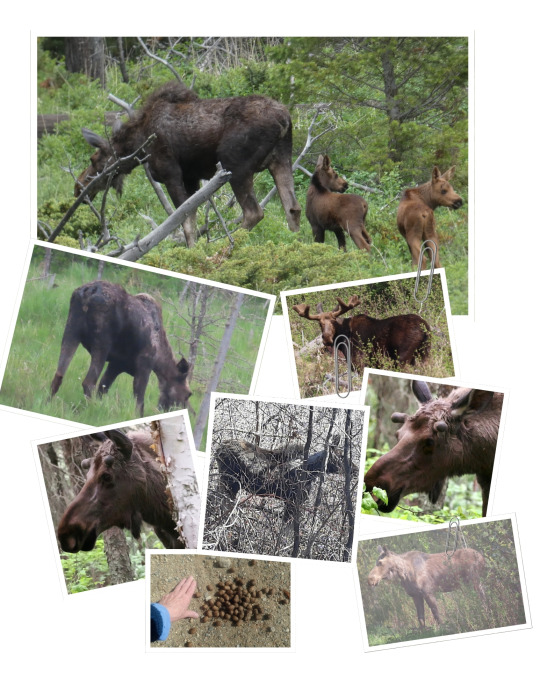
View On WordPress
#aquatic vegetation#bull moose#Canada#chronic wasting disease#City of Saskatoon#climate change and moose#coexisting with wildlife#Conservation Partnerships#cow moose#disease in moose#driving with moose#eco-friendly initiatives#ecological balance#ecological education#environment#environmental awareness#environmental conservation#Environmental Education#fall moose behavior#feeding moose#Friends of the Saskatoon Afforestation Areas#FriendsAreas#George Genereux Park#George Genereux Urban REgional Park#habitat fragmentation#habitat preservation#human impact on moose#human-wildlife coexistence#illegal feeding#indigenous knowledge systems
0 notes
Text
Best Behavior (Part 2)
Tmnt Bayverse Leonardo x (fem) Reader
MDNI 18+
Description - You were already hanging on by a thread—working late shifts, battling anxiety, and going through the motions of a life that never felt like yours.But one wrong turn after work leaves you bleeding, disoriented, and running for your life. A desperate escape drops you straight into the underbelly of New York—literally.When you wake up, you’re surrounded by four mutant turtles, all questions and secrets. As you heal, learn, and try to reclaim some sense of control, you find yourself drawn to the one who holds himself the tightest.
Part 1 -> Here
Part 3 -> Here
•
•
•
•
It had been two days. Two long, achy, surreal days. You hadn’t told anyone. Not your coworkers. Not your family. Not your friends.
Who would believe you anyway?
You’d almost convinced yourself it was some kind of stress dream—until you caught your reflection brushing your teeth and spotted the healing stitches on your forearm. Or the random bruises that bloomed deeper purple every hour.
Yeah. No dream.
You hadn’t heard from them since that night, either. No mystery texts. No shadow outside your window. Just silence. You shook the thought from your head and pulled your hoodie tighter as you walked down the sidewalk. Your foot still twinged with every few steps, but you had rent to pay and bills piling up. So here you were, walking the same route back to your waitressing job—
When you got inside you immediately headed to the back not making eye contact with anyone yet— You swiped your apron from the hook in the breakroom, moving slower than usual.
Everything still hurt. Your arm, your side, your damn foot. Even your neck had that weird tension from sleeping crooked the last two nights. You could still feel the soreness down your spine from hitting the sewer floor so hard. Donnie said you’d be bruised up but lucky to be alive. And that stuck with you—because yeah, you’d felt pretty unlucky that night.
You tied the apron at your waist with a wince, then stepped through the swinging doors onto the diner floor.
“Girl.”
You turned—and there was Nicole. Forty-five. Big lashes. Bigger hoop earrings. Thick brown curls in a half-up bun. She wore her uniform way too cropped for regulation and talked like every word deserved its own exclamation point.
“Nicole,” you greeted her, trying to smile. But she was already walking toward you, eyes squinting.
“Babe,” she said again, softly this time. “What the hell happened to your face?”
Your heart jumped, but she wasn’t accusing. Just worried. You blinked. “What?”
She nodded at your jaw. You’d used concealer. Apparently not well enough. “And your arm. And you’re limping. Don’t play me, Y/n. You look like you got jumped.”
You opened your mouth, but she crossed her arms. “Don’t you dare say you’re fine.”
“I—I fell,” you said quickly, eyes darting away. “Like… really bad. On my way home the other night.”
Nicole tilted her head. “What, did you fall off a building?”
You snorted—because… kind of? “I just… I don’t really wanna talk about it, okay? But just know I’m fine now”
She watched you for a second, then stepped closer, lowering her voice. “Okay, but listen. If someone did this to you—like, a dude or some crazy customer—you tell me, got it? I got an older brother who just got out of prison and a pepper spray in my purse that could take down a moose.”
You cracked a real smile at that. “You’re insane.”
“Damn right I am. And don’t you forget it.” Nicole looped an arm around your shoulders—carefully, since she could tell you were still sore—and gave you a gentle squeeze. “C’mon. The usual crowd’s rolling in and you know Paul’s gonna leave a mess on table six.” You let out a soft breath and followed her onto the floor, trying not to limp too noticeably. But your thoughts were distant.
Every tray you carried. Every plate you dropped off. Every “Have a good night” you forced through a fake smile— You HAD to shake it off and refill more glasses of tea and water. You were being weird. They probably had lives of their own lives. missions. Whatever. You were just a blip on their radar.
— — — —
Your shift finally ended, and this time you didn’t even think about walking home.
You ordered an Uber the second you stepped outside, keeping your hoodie pulled up and your head down. You didn’t care that it cost more than you wanted to spend—you just wanted to get home without being followed, chased, or bleeding from a new place.
The ride was silent. You stared out the window, fingers brushing over the slight edge of gauze still tucked under your sleeve.
When you got back to your building, you kicked your shoes off with a groan— changed into some comfy PJs and headed straight for the cabinet grabbing your favorite wine glass then you grabbed a half-filled bottle of wine from the fridge, poured it, and made your way to climb the narrow stairwell to the rooftop. You’d always liked it up here—just tall enough to see the lights of Manhattan in the distance, just quiet enough to forget the chaos below. Your building wasn’t fancy, but this rooftop had become your little secret escape— up here, things slowed down.
You sat near the edge, legs crossed, a hoodie thrown over your shift uniform, your glass of wine resting against your knee. The city lights stretched out in front of you, and for a second—just a second—you could almost convince yourself that things were normal again.
that was until—
THUD—CLANG— “OW–DAMN–IS THAT A LAWM-CHAIR??”
You jumped in place as a massive figure dropped from above, tripped over the utility vent, and hit the rooftop landing on a folding lawn chair with a yelp and a dramatic tumble. You nearly spilled your wine.
“What the—?!”
“OOOUUU,” came a groan. “Okay, okay, not my smoothest entrance but like—10/10 for drama, right?” You stared wide-eyed as the orange-masked turtle—Mikey—sat up, rubbing his elbow with a pained grin. He spotted the wine in your hand immediately and lit up like a Times Square billboard.
“Ouuu whatcha drinkin’? Is that wine? Are we having a wine night?? Say less—I brought vibes!”
You blinked, still catching up. “You—you just—dropped out of nowhere! Are you okay??”
“Uh, yeah?” he said like it was obvious. “Rooftop entrances are my thing. Except when they’re not. Like now. This one’s gonna leave a bruise…” He finally stood upright, towering over you with that familiar Mikey energy, bouncing on the balls of his feet. You tilted your head, smirking faintly. “Aren’t you supposed to be a ninja?”
“EXCUSE you—I am a ninja.”
“Yeah? Thought ninjas were supposed to be quiet.”
“Hey now—ninja code doesn’t cover rooftop furniture assaults, okay? That folding chair came outta nowhere.” You actually laughed, covering your mouth with your hand. He grinned like he just scored a win.
“Oh! I come bearing gifts,” he added proudly, reaching into his bag and pulling out… Your purse.
“Ta-da!”
You gasped. “Wait—how did you…I thought that guy stole it from me?”
“Leo snagged it before you left the lair, but I called dibs on the delivery so I could see your beautiful face again” he said proudly, handing it over. “Also, side note, you really need to clean this out. I found, like, five crumpled gum wrappers, two ancient pens, and a very expired Starbucks gift card.”
You blinked. “You went through it?!”
He looked offended. “I had to make sure it wasn’t, like, booby-trapped! Ninja safety protocol.”
You narrowed your eyes. “Mhm.”
“…Also you have some really good smelling perfume samples in there.”
You stared.
“Yeah,” he added with a wink. “Donnie found your socials. I might’ve peeked. Great playlists, by the way. Kinda vibey. Bit dramatic. Definitely single.”
“Personal life is out the window” You were laughing now, shaking your head as you clutched your purse to your chest.
Mikey’s voice softened just a little as he stepped beside you, crouching near the ledge.
“You, uh… haven’t told anyone, right?”
You glanced over. “About…?”
“Us,” he said, suddenly serious. “About what happened. Who we are. Where you were. My brothers… they’d totally flip if someone found out. Leo’s already in big brother threat mode.”
You nodded quickly. “No. I didn’t say anything. I won’t.”
He relaxed, giving you a warm smile. “Good. ‘Cause, y’know…we’d probably have to kill you if you did.”
Your eyes went wide. “what?!”
Mikey let out a laugh. “I’m just joking’ shortcake. But seriously your like deep in this now and you really can’t be telling people”
You raised your mug of wine. “Great. Always wanted to join a mutant turtle gang.” He clinked an imaginary glass with you. “Welcome to the family.”
— — — —
You were mid-sip, half-laughing as Mikey recounted some insane story about Donnie blowing up one of their old TVs “accidentally,” when a low thump behind you cut the moment short.
Your eyes flicked over your shoulder just in time to see a tall, shadowy figure drop silently onto the rooftop—sword sheaths and all.
Mikey turned, still holding the wine bottle he had absolutely not asked permission to touch. “Ohhhhhh,” he drawled, grinning wide. “Lookie lookie—it’s fearless leader Leo!”
Leo’s sigh was audible. “Mikey,” he said flatly, stepping forward, “you said you’d be back in five minutes.”
Leo deadpanned. “It’s been two hours.”
You coughed, barely holding in a laugh. Mikey glanced your way and gave you an exaggerated shrug.
“Time flies when you’re charming and socially gifted.”
Leo crossed his arms, clearly unamused. “You were supposed to check in. Donnie thought you might’ve got attacked.”
“Nah, I was just… y’know… debriefing.”
“Debriefing?” Leo echoed.
Mikey nodded solemnly. “Yep. Making sure our new friend is emotionally stable and still not planning to rat us out to Buzzfeed or TMZ.”
You snorted into your glass, and Leo’s eyes cut over to you for the first time.
“You haven’t told anyone… right?” he asked, his voice softer, more serious.
You shook your head. “No. Haven’t said a word. My coworkers thinks I got mugged by a pigeon.”
Mikey cackled.
Leo gave a small nod. “Good. Keep it that way. We’re not exactly… built for attention.”
Mikey jabbed a thumb at Leo. “Yeah, he’s shy.”
“I’m cautious,” Leo corrected. “You’re reckless.”
“And handsome.”
You smiled, giggling, glancing between them, your nerves starting to ease again.
Leo exhaled slowly, gaze lingering on you a beat too long. “We should go. Our patrol for tonight is done with.”
Mikey tossed the now-empty wine bottle in the trash can near the rooftop door. “Alright, alright.”
Leo arched a brow. “You gave her wine?” asking his younger brother as they started to walk off towards the edge of the building
“She already had the wine,” Mikey defended. “I just… encouraged the vibe.”
Leo shook his head, turning slightly. But before he could fully step back into the shadows, Mikey quickly walked back over to you and leaned close to you and whispered, just loud enough for Leo to hear:
“Seriously though—Leo has been watching this building for three nights straight.”
Leo’s voice cut in, stern. “Mikey—”
“Protectively!” Mikey grinned wide. “Like a heroic, totally not obsessed bodyguard. Super respectful. Very emotionally repressed.”
“Mikey. Let’s go. Now”
He raised his hands. “I’m done! I’m done! Just letting her know she’s in good hands”
Leo let out a quiet growl, rubbing the bridge of his nose. “Let’s go before I toss you off the roof.”
Mikey nudged you with a wink. “He won’t. He’s too noble.” You laughed, half from nerves and half from actual amusement, watching the two disappear into the shadows—Leo with his usual stoic glide, Mikey practically skipping behind.
You watched then both disappear into the city like you did the few nights before. You smiled to yourself feeling excited about life is about to throw at you.
— — — — — — — — — — — — — — — — — — — —

#tmnt 2016#tmnt 2014#leonardo tmnt#leo tmnt#tmnt bayverse#tmnt michelangelo#tmnt donatello#tmnt raphael#tmnt 2003#tmnt leonardo#tmnt au#teenage mutant ninja turtle imagine#teenage mutant vigilantes#teenage mutant ninja turtles#bayverse leonardo#bayverse tmnt#bayverse donnie#bayverse raphael#bayverse leo x reader#bayverse mikey#bayverse michelangelo
54 notes
·
View notes
Text
I can't believe i made a whole ass species lore just for a wild kratts oc my god i never thought it could come this way but..thats the fun of it i guess LMAOO
Anyways..
Meet the Sickle-horned Equdore, a species of antelope found in the northern part of Kazakhstan where forests lie. Where their ancestors, the bluebuck, migrated from the south coast of africa to central asia.
The word Equdore (pronounced "eqoodor") means equine-like antelope, due to their appearance being similar to those of modern day horses though due to their two hooved they are not considered in the equus family.


The sexual dymorphism of the Sickle-horned Equdores are somewhat similar to those of deers or mooses, the male being bigger and more patterned with bigger horns. However not all male Sickle-horns have big horns, some have smaller horns usually from too much stress of poor diet during development of the horns growing, female Sickle-horns prefer those with bigger horns to show their health and potential. Male Sickle-horns are the only sex with the distinctive sickle shaped horns, hence their name.
Female Sickle-horned Equdores are slightly smaller than the male by a foot, however just because they are smaller than the males, does not mean they are small compared by a human, standing 8 feet tall. Female Sickle-horns have more curved horns that doesn't resemble an actual sickle, while the male horns of the Sickle-horned Equdore are shaped for both protection and attraction, female horns are only used for protection.
The social behavior of them are also similar to wild horses or chickens. One alpha male (fuck..i can't take that phrase seriously due to THOSE alpha male dudes you see in instagram reels or in podcasts..) and a herd, usually 8 to 15 females, the male provides safety and food by communicating that theres an abundance of food, if the male..example, finds a fruit tree, he will call the herd and let them eat first by helping to kick the tree so the fruits could fall down, easier to pick on, and the male will eat after a few have eaten already.
The unique part of the Sickle-horned Equdore is each pattern from each individual species are different, so they have their own set of pattern only own by those who bear it, making them easy to distinguish from others. And their fur is blue in colour, while not very blue, if you colorpicked their fur the color is more the blue area even though it looks more purple. Blue pigment is very- almost impossible in mammals, some "blue" furred mammals are usually more grey.
I also even made what the creature power suits of the species, both sex, though the powersuits are still a big smaller compared to the actual animal, they still stand around 7-8 feet. Poor chris, he's more teal and blue than his usual green colour, like the blue heron episode...

So what are the Sickle-horned Equdores known for other than their sickle-shaped horns and their blue fur?
They are famous for the creation of the mythical greek animal, the unicorn. When greek adventurers went to central asia, they discovered the rarest mutation of the Sickle-horns, the mutation that made them have a singular horn, while in real life unicorns were from the misinterpertation of rhinos, in my Wild Kratts universe, the unicorn mythology came from this species but historians theoried that it came from rhinoceros because they haven't found or rediscovered the species that created the famous fantasy animal in the first place.
This mutation is REALLY REALLY rare, less than 2 percent have this mutation that caused them to have a singular horn.
(Picture of Aoife and Einhorn. Oc on the left (Aoife) belongs to @martincrushcameback while Einhorn belongs to me.)
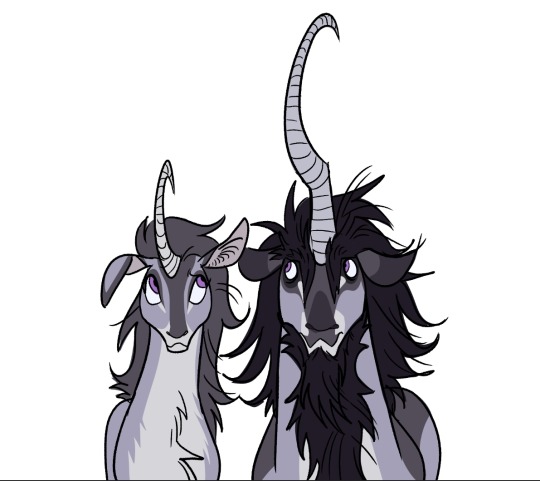
The burden of having such a unique birth defect is that you have a low chance of surviving or creating a herd of their own, female Sickle-horns with this condition are less likely to find a mate or a group to be accepted in, while males have a hard time to create their own herd, and their singular horn couldn't fight a male who already has a herd and they can't stand a chance, because whos more likely to win? A highly skilled person with two swords or the one that only has one and is average skilled?
One horns are so rare that records say only one was found, though many scientist disaproved the one horned as "not real" thinking the photo was painted to look like it had one horn, since they didn't believe that unicorns existed..lol
And Sickle-horned Equdores were once highly poached and hunted during the mongol empire, the people tried domesticating them so they could use them as a source of transportation for the extremely wealthy and war for the mightiest soldiers, unfortunately the domestication was a fail, so instead, they hunted them for their beautiful coat and horns for decor for the rich and those in power. So much that they reduced their population from a million to only 200 thousand left today. Their population is growing at a steady pace due to orginizations to protect these endangered animals. Fun fact, the Sickle-horned was rediscovered very early in the 1970's, historians found remnants of Sickle-horn hide and horns thinking these creatures are long extinct back in the 1900's.
Sooo..yeah, thats all i got for the species of Einhorn and Aoife..guuuhhh so much research..
Also, Equdore is a genus of antelope, meaning, like the big cat family including jaguars, tigers, lions and such, is their own family branch of the antelope family..MEANING...that there are other Equdore species not only existing to the Sickle-horned!
Also just to make sure Equdore is a fictional animal, there is no such genus of antelope called an Equdore..bah..
#fandom#wild kratts#art#fanart#artwork#art style#doodles#wild kratts fanart#wild kratts au#wild kratts oc#Einhorn#aoife the unicorn#Sickle-horned Equdore
140 notes
·
View notes
Text

Day in Fandom History: April 30…
The citizens of Lone Moose celebrate the upcoming Rear Gifts Festival, an annual celebration of moose turds falling from the helicopter, with the Tobins, Tuntleys, and Evanoffs, by Mayor Pepper's orders, to be on their best behavior as Ham attempts to make a new friend his own age. “Rear Genius Adventure” premiered on this day, 1 Year Ago.
#Day in Fandom History#1 Year Ago#The Great North#Season 3#Episode 19#Rear Genius Adventure#Cartoon#Animation
2 notes
·
View notes
Text
YELLOWSTONE COLONIES SEASONS
let’s start off with something nice and simple: seasons!
yellowstone national park is a sprawling landscape located in the temperate coniferous forest biome, which is marked by warm summers and cool winters. being temperate, the land does cycle through four seasons—but, they’re not clearly defined by deciduous forest standards of 3-month-long springs, summers, autumns, and winters. additionally, because the dominant tree type is evergreens, observing the changes of the leaves is not a reliable indicator of the season.
because of this, the yellowstone cats have developed their own names, lengths, and identifiers for their seasons, where they look to animal behaviors to determine the current one!
THE BLOOM
the bloom is the equivalent of early spring, with march being the only month of this season. it is named after how the land wakens from its winter slumber, ‘blooming’ into a flourishing land of plenty once more. the most common indicators of the arrival of the bloom are:
the appearance of mountain bluebirds, western meadowlarks, ospreys, and american robins
the emergence of grizzly bears from hibernation
and humans snowplowing the park's interior roads
THE THAW
the second season is called the thaw, which equates to late spring and the entirety of summer. its duration is april to august, and it is called the thaw as it is the season when animal activity really kicks up. winter fully sheds its grip on the environment, and the cats do not yet have to prepare for the next freeze. it is marked by:
APRIL
the appearance of ruby-crowned kinglets and wilson's snipes
the emergence of black bears, marmots, ground squirrels, and chorus frogs from hibernation
bison calving
bison and elk returning to higher elevations, with elk dropping and regrowing their antlers
growth of buttercups, shooting stars, and pasqueflowers
and an increase in human visitors and cars on the road
MAY & JUNE
elk, moose, pronghorn, and bighorn sheep calving
wolf pups emerging from their dens
cutthroat trout starting to spawn
ruffed grouse starting to drum
growth of glacier lilies and bitterroot
water levels rising due to snowmelt
and humans fishing in the rivers
JULY & AUGUST
bison rut
water levels dropping
wildfires are more prone to occur
and a greater increase in human visitors and cars on the road
THE FEAST
the feast is the most important season, being their autumn before winter. taking place from september to october, the third season is named for how animals prepare for hibernation by becoming hyperphagic and stocking up on food! the traditional indicators of the start of this season are:
elk rut
animals preparing for hibernation
deciduous trees entering fall colors
snow accumulating at higher elevations
and a decrease in human visitors and cars on the road
THE FREEZE
the final season is called the freeze, which is appropriately named for being the colonies’ winter! grueling and arduous, the freeze tends to be the most challenging season to survive through, especially if one inadequately prepared during the feast. it spans november to february, and is signified by:
bighorn sheep rut
bison and elk migrating to lower elevations
mule and whitetail deer shedding and regrowing their antlers
coyotes and foxes snow diving
snow accumulating at lower elevations
and a greater decrease in human visitors and cars on the road
#yellowstone colonies#yellowstone colonies environment#working names for the bloom were also the wake and the rise!#curse tumblr formatting and its lack of sub-bulletpoints...#warriors inspired#warriors worldbuilding#warrior cats worldbuilding#worldbuilding#b
10 notes
·
View notes
Text
Moose are so much bigger than you think. And not only can they hurt you if they feel threatened or territorial, sometimes they just don't like the way you looked at them, and then you're dead.
At the time I made this post, I'd forgotten about some photos I took last October at a large-acreage facility out in the PNW. I've wanted to talk about them but was worried that without proper context they might encourage copycat behavior. I think this is the right place for them.
But to be clear.
DO NOT DO THIS. Do not approach moose. Ever.
Even in a captive setting, with hand-raised moose, this is... a really bad idea, honestly.
So last fall, I was playing with a new telephoto lens, and I decided I'd go out to the local facility that focuses on native species. They have a large-acreage drive-through with bison, elk, deer, and moose, and I took a special tour in a staff-driven jeep to be able to get better photos.
This facility has three hand-raised juvenile moose, all rescues from Alaska. A bull, Atlas, and two cows, Luna and Callisto. At the time I was there, they would have been about a year and a half old. Very importantly, they were hand-raised by the keeper staff. Now that the moose are older, they live in the 435-acre drive-through section of the park, which is very heavily wooded and has a lot of complex terrain.
So we're out in the drive-through section of the park nice and early in the morning. The tour guide is on the radio with keeper staff discussing where the moose might have bedded down overnight, and once they're found, we drive over there. And we watch as this keeper pulls up in a truck near the moose... and then gets out? and walks directly over to the moose? And then gets directly down on the ground with them?
Everyone else on the tour is cooing about how sweet it is, and the tour guide is telling us about the bond between the staff and the moose they hand-raised. Meanwhile my jaw is on the floor. I asked the tour guide if this was normal husbandry practice (because how??) and was told yes, this is how the keeper staff regularly interact with the moose. It's known by management, considered appropriate, and basically encouraged.
(AN: Normally, I'd edit the keepers face out of photos like this, to protect their privacy. However, the facility regularly posts him interacting with the moose on their social media, including his full face and his name.)
Two months before, in a press release, the facility had indicated that all three calves now stood almost 5 feet tall at the shoulder. Atlas weighed in at over 730 pounds at the time, and the cows were 664 pounds and 554 pounds respectively.
We sit there for a while and watch the keeper kneel on the ground with one of the cows, checking over her head and neck and giving her scratches.
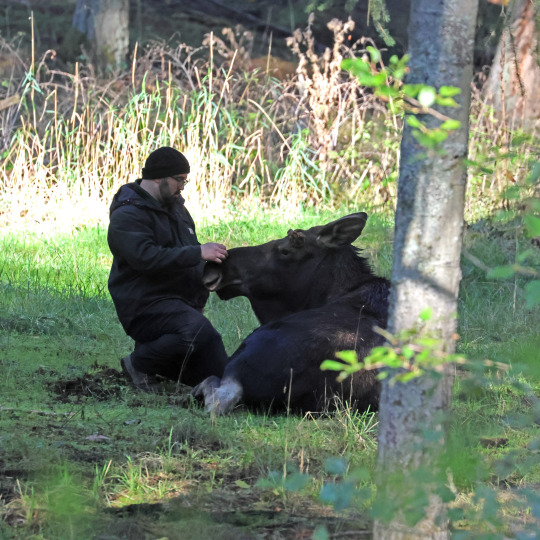
After a while he gets up and moves over to the other cow, who stands patiently while he checks her body over (the tour guide tells us this is the most effective way for the staff to remove ticks). At times, she rests her head on his body while he's looking at her chest and legs, as pictured below.
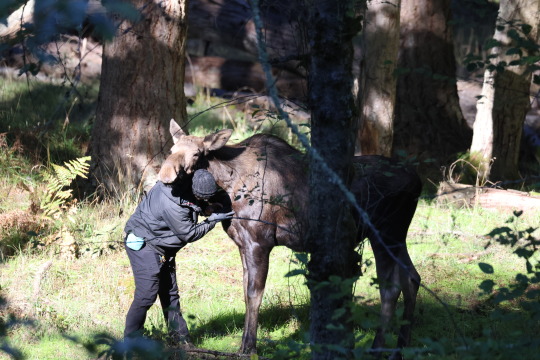
Atlas, the bull, wandered down eventually. I don't have photos of him getting a tick check. The keeper then grabbed a stick and used it to pull high-up branches down, so all three moose could snack on the leaves. That put him in close proximity to all three as they grazed.
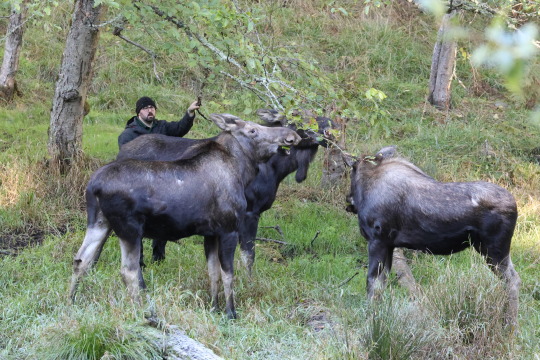
This next part was the most heart-stopping thing I've seen in person.
Atlas, the tour guide told us, was just coming out of his first rut. When in rut, moose are very hormonal and very dangerous to be around. We were told they'd pretty much stayed free-contact with him throughout, because he had a good relationship with his keepers.
Sure, but... then we watched him repeatedly try to push the keeper over. I don't know what the provocation was (or if it was just the end of rut), but partway through eating the proffered branch, he started pinning his ears back and eyeballing the keeper. When that didn't do anything, Atlas progressed to shoving the guy backwards with his head.
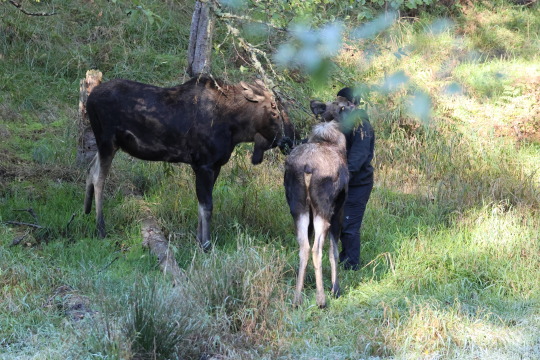

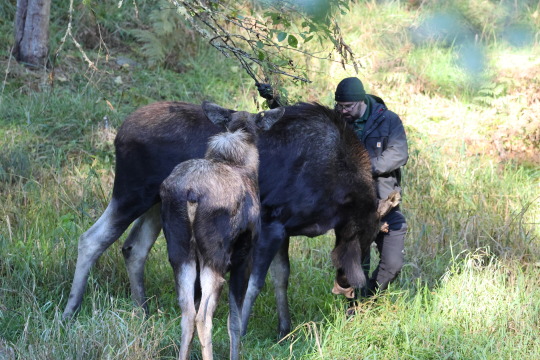
Atlas even followed the keeper after he moved away, approached him, and pushed him over again. I've got probably... five discrete instances of the behavior in my photos? There wasn't a ton of effort behind it, but the keeper had to hustle to not be knocked down. What really worried me was that the keeper didn't seem distressed by the interaction, or like it was even really worthy of much notice - it felt, watching it and reviewing my photos, like it was just a normal thing. Which. uh. yikes.
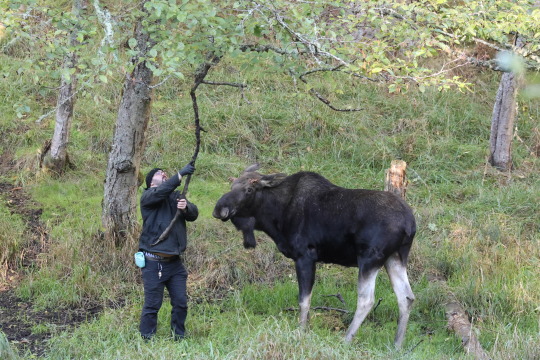
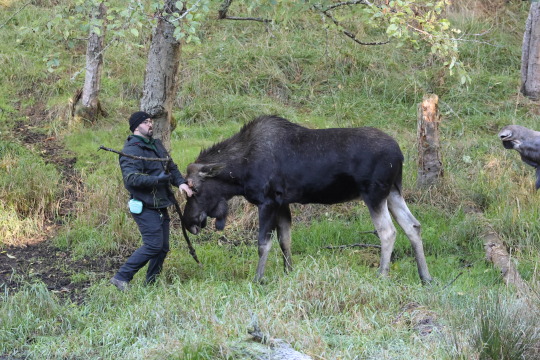
This is an AZA accredited facility. The last thing I ever expected to see is staff working free-contact with moose (even yearlings). It's dangerous, it's a liability for the zoo, and it encourages guests to think that it is safe to interact with moose. No matter how many times a tour guide stresses that "this is only safe because of x", you know people are just gonna go "oh man I want to do that too."
To be clear: I don't think this is anything to do with the specific keeper's choices. The facility's Facebook page shows videos regularly filmed by different keepers who are in that habitat, free-contact with the moose. Even now that they're almost two years old, and even bigger. I think it's just what they're told the job is.
Now, I don't have personal experience working with hoofstock, maybe there was something I was missing. So I reached out to a number of career zoo professionals who have that background and asked for their thoughts. The response, to a T, was basically “this is playing with fire." They stressed that hoofstock - especially hand-raised animals- can/will randomly decide to hurt you. Even if they've known you forever, despite a previously good relationship, without a visible trigger. "Smaller" deer and antelope regularly charge, strike, gore, trample, and kill people. Those incidents don't tend to happen with captive moose because nobody goes in with them.
I'm really concerned for the safety of those zookeepers in the long-term. Here's the thing: I took those photos with a very good telephoto lens from across a lake, and they were at the very end of my zoom range. We were probably a good five-ten minute drive away from being able to reach him, over rough roads with tight turns and steep terrain. Coming in from outside the drive-through would have taken even longer. That keeper was out there, alone, and not close enough to his car to run back to it it easily. I don't see a radio on his belt (he was using a cell phone to document stuff about body condition) or any sort of protective backup gear (like how carnivore keepers carry pepper spray). And staff have clearly been OK'd (maybe even asked, idk) to use their phones to take photos and/or create social media content while they're out there!
If something were to go wrong... there's nobody nearby those keepers to help. At least if there were two people out there together, the second person could call for help, or pull you to safety, or try to distract the moose. Something. They could do something. With the way the facility appears to have their husbandry set up, each keeper is just out there alone. Nobody can get there quickly. They're on their own, and that's a terrible place to be if even a half-grown moose decides it wants to end you.
TL;DR? No matter what you see the "professionals" doing, don't fuck with moose. It's important to remember that even they (or their management) can make make dangerous, irresponsible decisions and not consider the optics of a situation. Instead, follow the rule of thumb: if you hold your thumb up in the direction of a wild animal, can you blot them out? If your thumb doesn't cover the entire outline of the wild animal, you're too damn close.
If there was one animal literacy thing I could change with a wave of a wand, it would be increasing people's understanding of how dangerous megafauna are. I think that in the US (and probably other Western countries too), we're so removed from wildlife and even large domesticated animals that people really have no perspective on how much a big animal can fuck you up. Even if they're "gentle."
This is a discussion going on on Twitter, too, the last few days: there was a thing where an Iditarod musher shot a moose to protect their team, and a lot of people are confused as to why that needed to happen. Apparently this moose had been hanging around the course for quite a while and was becoming quite dangerous to the sled dog teams. Moose are territorial and not to be fucked with. Everyone from Alaska or areas with moose are like "yup, that's just reality."
Same thing with the bison birth I watched last year. Folk really thought the staff should be in the habitat on the ground with the bison herd, helping with the birth. Sure, that's what we do with cows if we have to, but... bison are definitely not cows and, again, will squish you.
People tend to get it more with the predators. Few people will argue that a cougar or an alligator or a bear isn't dangerous. I think people kinda go both ways on wild pigs / boars depending on their experience. But herbivores or things that don't look traditionally pointy... it just kinda doesn't click.
Any large animal is probably stronger than you think and more likely to hurt you than you realize. Be it a dolphin, an elk, a sea lion, or even an emperor penguin... just don't go near them, buds.
21K notes
·
View notes
Text
Best of Acadia National Park and Bar Harbor Maine
In this episode, the FAQ is: “What is air travel like these days, and what is different?
Today’s Destination is Acadia National Park
Today’s Mistake- My own car crash in parking garage
Travel Advice: Travel pillows FOR SLEEPING on planes
FAQ: “What is air travel like these days, and what is different?
AARP is offering some airline travel tips that may answer this question. First, some facts.
In 2019, the FAA reported 146 cases of bad behavior on planes, but in 2021, that number grew to more than 1,000. That was out of nearly 6,000 cases of unruly passengers.
Airplane etiquette is more important because we are all hyper-aware of those around us.
Some people get to the airport these days, forgetting basic kindness. The first rule of respectful travel is to accept the rules: Observe mask mandates, boarding processes, and carry-on restrictions. Beyond that, there are steps you can take to make travel a little more pleasant for everyone and avoid conflict. Here are five tips:
Don’t hog the overhead bins
Greet your flight attendant
Prepare yourself ahead of time.
Don’t escalate a conflict.
Don’t bring stinky food on board.
Source: https://www.aarp.org/travel/travel-tips/transportation/info-2022/flying-etiquette.html?intcmp=DC-TRV-MAIN-BB
Destination: Acadia National Park, Maine
Woodland Rocky beaches and Granite Peaks mark Acadia. It's a good destination for a Solo Traveler or with a friend. ALL seasons have something to offer.
At 4 million visits a year, it's one of the top 10 most-visited national parks in the United States. Visitors can explore 27 miles of historic motor roads, hike 158 miles of trails, and explore 45 miles of carriage roads. A shuttle service runs through the park from late June through late October, so you don't need a car during those times. The weather is temperate due to the ocean climate, and it rains often. You may also see morning fog in the summer.
What is significant about the geography at Acadia National Park?
The highest point on the United States East Coast is Cadillac Mountain. You will find Wildlife such as moose, bears, seabirds, and Wales. You are close to Bar Harbor, where restaurants, shops, and entertainment are popular after your visit. You will like the smell of the salty air as you walk through the national park and along the streets of Bar Harbor. My favorite time of year is the fall, when the Fall colors are magnificent. I had trouble finding a hotel nearby on Columbus Day weekend. I had to drive quite a ways to find a hotel when I didn't make reservations that week.
Bar Harbor, Mount Desert Island’s largest community, is a five‐hour drive from Boston and 50 miles from Bangor International Airport. It is the second largest on the eastern seaboard behind Long Island.
https://www.visitbarharbor.com/
The springtime is lovely and cool. Do not expect to be in a very hot area this time of year. It is a bit of a drive to get there, but it's worth it. I suggest flying to Boston and driving 5 hours, or about 50 miles from Bangor, Maine.
https://www.nps.gov/acad/planyourvisit/faqs.htm
https://acadiamagic.com/
https://www.nps.gov/acad/index.htm
https://acadiamagic.com/schoodic/map.htm
Today’s Travel Advice-Travel neck pillows reviewed.
Neck pillows are foam, some with straps around the headrest, to help you sleep on the plane. I did a TWITTER POLL to discover your favorites. TRTL pillow won. It has a cushioned foam section that you can adjust to be anywhere around your neck, whether you like to fall asleep forward or to the side. The next favorite is the launch of the Trtl Plus. The new version has adjustable neck support, allowing Goldilocks-style comfort and the fabric wrap is vented with a breathable mesh.
https://www.travelandleisure.com/style/travel-accessories/best-travel-pillows
Connect with Dr Travelbest
Website
Drmarytravelbest.com
Mary Beth on Twitter
Dr. Mary Travelbest Twitter
Dr. Mary Travelbest Facebook Page
Dr. Mary Travelbest Facebook Group
Dr. Mary Travelbest Instagram
Check out this Dr Travelbest episode!
1 note
·
View note
Text
Big Game Hunting in Idaho: A Wilderness Adventure
Idaho is a haven for outdoor enthusiasts, and for hunters, it offers some of the best opportunities for big game hunting in the United States. Known for its rugged terrain, vast wilderness, and diverse wildlife, Idaho provides a thrilling experience for seasoned hunters and newcomers alike. From majestic elk roaming the mountains to elusive mountain lions stalking the forests, Idaho’s big game hunting season is not just a sport but an adventure of a lifetime.
Idaho’s Big Game Species
Idaho is home to a wide variety of big game species that attract hunters from across the country. Some of the most sought-after species include:
Elk: One of the most popular big game animals in Idaho, elk hunting is a staple for many hunters. With herds spread across the state, Idaho offers both over-the-counter and controlled hunt tags, allowing hunters flexibility in pursuing this majestic animal.
Mule Deer: Known for their large size and impressive antlers, mule deer are a favorite target for many. They can be found in Idaho’s high deserts and mountainous regions, offering a challenging yet rewarding hunt.
White-tailed Deer: Unlike mule deer, white-tailed deer are more commonly found in Idaho’s forested areas, particularly in the northern regions. They are smaller than mule deer but still provide a thrilling hunting experience.
Pronghorn Antelope: The pronghorn is the fastest land animal in North America, making it a unique and challenging hunt. Idaho offers both rifle and archery seasons for this species.
Moose: Idaho’s moose are massive, and hunting them requires patience, skill, and luck. Due to their size and the challenge of locating them in remote areas, moose hunting is considered a once-in-a-lifetime experience for many hunters.
Mountain Lion: Also known as cougars, mountain lions are elusive and often difficult to track. Hunting them requires knowledge of their behavior and habitat, and many hunters use dogs to aid in the chase.
Black Bear: Idaho offers some of the best black bear hunting opportunities in the lower 48 states. With two bear seasons (spring and fall), hunters have the chance to track and harvest these animals in various terrains.
Bighorn Sheep: Bighorn sheep hunting is one of the most coveted experiences in Idaho. The rugged cliffs and steep mountains make this one of the most challenging and prestigious hunts in the state.
Hunting Seasons and Regulations
Idaho’s big game hunting seasons vary depending on the species, region, and weapon type (rifle, archery, muzzleloader). Most seasons typically run in the fall, but some species, such as black bear, have spring hunting opportunities.
Idaho offers both over-the-counter (OTC) tags for species like elk and deer, as well as controlled hunt permits for more limited species, like moose or bighorn sheep. Controlled hunts are typically awarded through a lottery system, and hunters must apply during specific periods to be considered.
The Idaho Department of Fish and Game (IDFG) regulates all hunting activities in the state, ensuring sustainable wildlife populations and ethical hunting practices. Hunters must follow IDFG regulations closely, including bag limits, hunting zones, and weapon restrictions.
Choosing the Right Gear
When preparing for a big game hunt in Idaho, selecting the right gear is essential. Given the state’s varied and often extreme terrain, hunters should prioritize quality equipment. Here are a few essentials:
Rifles and Bows: Depending on the game, choosing the appropriate caliber or bow is critical. Elk and moose require powerful rifles capable of long-range shots, while mule deer and antelope may allow for smaller calibers.
Optics: Idaho’s open landscapes make spotting big game from a distance crucial. Investing in quality binoculars and rifle scopes can greatly enhance your success.
Clothing and Footwear: Idaho’s weather can change rapidly, especially in the high mountains. Layered clothing designed for both cold and heat is recommended, along with waterproof, insulated boots for navigating rugged terrain.
Survival Gear: Always pack essentials like a first aid kit, navigation tools (GPS, maps, and compass), fire-starting tools, and enough food and water for extended stays in the wilderness.
Hunting Ethics and Conservation
Ethical hunting is a cornerstone of Idaho’s outdoor culture. The state emphasizes fair chase principles, meaning hunters should avoid practices like using motor vehicles or drones to pursue animals. Respect for wildlife and the land is paramount, and hunters are encouraged to practice leave-no-trace principles, ensuring that Idaho’s wild spaces remain pristine for future generations.
Idaho’s hunting community also plays an important role in conservation. Hunting fees and tag sales contribute directly to wildlife management, habitat preservation, and species conservation. By hunting responsibly and respecting the land, Idaho’s hunters help ensure the continued health of the state’s ecosystems.
A Wilderness Experience Like No Other
Big game hunting in Idaho is more than just a sport; it’s a connection to nature, a test of endurance, and an exploration of some of the most beautiful landscapes in America. Whether you’re stalking a mule deer in the high desert or tracking a mountain lion through dense forests, Idaho offers a hunting experience that’s both challenging and deeply rewarding.
So, pack your gear, grab your tags, and prepare for an unforgettable adventure in the wilds of Idaho. Whether you’re a seasoned hunter or a first-timer, Idaho’s big game hunting season promises to leave you with memories, stories, and, if you’re lucky, a trophy to take home.
0 notes
Text
The Ontario Moose Quest: Strategies for a Successful Hunt
Moose hunting in Ontario is a challenging and rewarding pursuit that draws hunters from across North America. The province's vast wilderness, abundant moose population, and well-managed hunting regulations make it an ideal destination for those seeking to bag one of North America's largest land mammals. Here's a comprehensive guide to finding success in your Ontario moose hunt.
Understanding the terrain is crucial. Ontario's moose habitat varies from the boreal forests of the north to the mixed woodlands of the central and southern regions. Moose prefer areas with a mix of young forest growth, providing browse, and mature forests offering cover. Wetlands, lake edges, and recent burn areas are also prime moose territory. Familiarizing yourself with these habitats will significantly increase your chances of encountering moose.
Timing is everything in moose hunting. The season typically runs from mid-September to mid-December, varying by wildlife management unit (WMU). The rut, or breeding season, usually peaks in late September to early October. During this time, bulls are more responsive to calls and less wary, making it an ideal period for hunting. However, early season hunts can be challenging due to warm weather and dense foliage.
Proper licensing is essential. Ontario operates on a lottery system for moose tags, with applications typically due in the spring for the fall hunt. Hunters must possess a valid Outdoors Card, a moose license, and the appropriate tag for the WMU they're hunting in. It's crucial to understand and follow all regulations, including specific WMU rules and firearm restrictions.
Scouting is a key component of a successful moose hunt. If possible, visit your hunting area before the season to look for signs of moose activity. Fresh tracks, droppings, and browsed vegetation are all indicators of moose presence. Game cameras can be valuable tools for monitoring moose movements in your chosen area.
Calling is an effective technique, especially during the rut. Bull grunts and cow calls can attract moose from considerable distances. Practice your calling techniques before the hunt, as authentic-sounding calls are more likely to elicit a response. Remember that calling may also attract other hunters, so always be sure of your target.
Still hunting and spot-and-stalk are common methods in Ontario. Moving slowly and quietly through likely moose habitat, stopping frequently to glass and listen, can be very effective. Moose have excellent hearing but poor eyesight, so movement is often more likely to spook them than sound.
For those hunting in more open areas or clear-cuts, setting up on a vantage point and glassing for moose can be productive. Moose are most active during the early morning and late evening hours, so these are prime times for spotting.
Weather plays a significant role in moose behavior. Cool, overcast days are ideal for hunting, as moose are more likely to be active throughout the day. After a rain, moose often move to open areas to dry off, providing good spotting opportunities.
Physical preparation is crucial for moose hunting. The terrain can be challenging, and moose are large animals. Being in good physical condition will not only make your hunt more enjoyable but also increase your chances of success, especially if you need to track a wounded animal or pack out meat over difficult terrain.
Proper equipment is essential. A rifle of sufficient caliber (typically .30 caliber or larger) is necessary for ethical kills. Quality optics, both binoculars and a rifle scope, are invaluable. Appropriate clothing for the variable weather conditions is crucial, as is good footwear for navigating rough terrain.
Consider hiring a guide, especially if it's your first time hunting moose in Ontario. Local guides have invaluable knowledge of moose behavior, preferred habitats, and effective hunting techniques for the specific area.
After a successful hunt, be prepared for the work of field dressing and meat preservation. Moose are large animals, and proper handling of the meat is crucial. Many hunters choose to quarter the animal in the field for easier transport.
Remember, patience is key in moose hunting. These animals have vast home ranges and can be elusive. A successful hunt often requires perseverance and the willingness to spend long hours in the field.
By understanding moose behavior, properly preparing, and employing effective hunting techniques, you can increase your chances of a successful moose hunt in Ontario's beautiful wilderness. Always hunt ethically and safely, respecting both the animal and the environment. https://uchilakelodge.com/hunting/
1 note
·
View note
Text
WILD LOCALS YOU MIGHT MEET ON YOUR TRIP TO BANFF NATIONAL PARK
Banff National Park, nestled in the heart of the Canadian Rockies, is a paradise for nature enthusiasts and wildlife lovers alike. As visitors explore this pristine wilderness, they're likely to encounter a diverse array of fascinating creatures that call this rugged landscape home. From tiny mountain-dwelling mammals to majestic ungulates and formidable predators, the park offers countless opportunities for wildlife viewing. This blog will introduce some of the wild locals that tourists might spot during their stay in Banff, along with tips for responsible wildlife watching and information about comfortable accommodations like hotels in Banff Alberta.
Pika
One of the most endearing inhabitants of Banff's rocky slopes is the pika, a small, rabbit-like mammal that thrives in high-altitude environments. These furry little creatures are masters of survival, adapting to the harsh mountain climate with their round bodies, short limbs, and thick fur. Visitors hiking in the park's alpine areas might hear the pika's distinctive high-pitched call before spotting one darting between rocks.
Pikas are industrious animals, spending much of the summer gathering vegetation to create "haypiles" for winter sustenance. While exploring the park's trails, keep an eye out for these busy foragers near talus slopes and rock piles. Remember to maintain a respectful distance and use binoculars for a closer look without disturbing their natural behavior.
After a day of pika-watching, visitors can retreat to the comfort of hotels in Banff Alberta, such as Charltons Banff, to relax and plan their next wildlife adventure.
Hoary Marmot
Another charismatic resident of Banff's alpine and subalpine regions is the hoary marmot. These large, ground-dwelling rodents are easily recognizable by their stocky bodies, fluffy fur, and distinctive whistling alarm call that echoes across the mountainsides. Hoary marmots are often spotted sunbathing on rocks or foraging for vegetation in meadows above the treeline.
These social animals live in colonies, and visitors might observe their playful interactions and grooming behaviors. The best time to see hoary marmots is during the warmer months, as they hibernate for up to eight months of the year. When planning a trip to Banff, consider staying at hotels in Banff Alberta that offer easy access to hiking trails in marmot habitat.
Wapiti (Elk)
One of the most iconic animals in Banff National Park is the wapiti, commonly known as elk. These impressive ungulates are a common sight in the Bow Valley, particularly during the fall rutting season when bull elk engage in dramatic displays and vocalizations to attract mates. Elk can be spotted grazing in open meadows, along roadsides, and even wandering through the town of Banff itself.
While elk are generally peaceful, it's crucial to give them plenty of space, especially during the rutting season when bulls can be aggressive. Visitors should never approach or feed elk, as this can lead to dangerous encounters and disrupt their natural behaviors. Many hotels in Banff Alberta, including Charltons Banff, provide information on wildlife safety and viewing etiquette to ensure a positive experience for both tourists and animals.
Moose
The largest member of the deer family, the moose, is a majestic sight in Banff National Park. These imposing animals can be found in wetland areas, forests, and willow thickets throughout the park. Despite their size, moose can be surprisingly elusive, and spotting one requires patience and a bit of luck.
The best times to observe moose are during the early morning or late evening when they're most active. Look for them near bodies of water, where they often feed on aquatic vegetation. Visitors should exercise extreme caution if they encounter a moose, as these animals can be unpredictable and potentially dangerous if they feel threatened.
After a day of wildlife watching, guests can return to their hotels in Banff Alberta to share their moose-sighting stories and plan their next excursion into the park.
Mountain Goat
Banff's rugged mountain terrain is home to one of North America's most skilled climbers: the mountain goat. These sure-footed animals are adapted to life on steep, rocky slopes and can often be spotted navigating seemingly impossible cliff faces with ease. Their distinctive white coats and sharp black horns make them stand out against the rocky backdrop of the Canadian Rockies.
The best places to observe mountain goats are along high-elevation hiking trails and in areas with mineral licks, which attract these animals with essential nutrients. Visitors should bring binoculars or a spotting scope for the best views, as mountain goats often inhabit remote, hard-to-reach areas.
For those interested in mountain goat viewing, staying at hotels in Banff Alberta like Charltons Banff can provide convenient access to guided wildlife tours and information on the best viewing locations.
Black Bears
No discussion of Banff's wildlife would be complete without mentioning one of the park's most famous residents: the black bear. Despite their name, these bears can range in color from black to brown and even cinnamon. Black bears are often seen foraging for berries, nuts, and other vegetation in the park's forests and meadows.
While encountering a black bear can be an exciting experience, it's crucial to practice bear safety at all times. Visitors should make noise while hiking, travel in groups, and carry bear spray. If a bear is spotted, maintain a safe distance and never approach or feed the animal. Many hotels in Banff Alberta offer bear safety workshops and information to ensure guests are well-prepared for their outdoor adventures.
Responsible Wildlife Viewing
As visitors explore Banff National Park and encounter its diverse wildlife, it's essential to remember that these animals are wild and should be treated with respect and caution. Here are some key guidelines for responsible wildlife viewing:
Maintain a safe distance: Use binoculars or telephoto lenses to observe animals from afar.
Never feed wildlife: Human food can harm animals and alter their natural behaviors.
Stay on designated trails: This helps protect both wildlife habitat and visitor safety.
Be aware of your surroundings: Always watch for signs of wildlife activity and be prepared for unexpected encounters.
Follow park regulations: Obey all posted signs and guidelines for wildlife viewing and safety.
By following these guidelines, visitors can enjoy memorable wildlife experiences while helping to preserve the natural beauty and ecological balance of Banff National Park.
Banff National Park offers unparalleled opportunities to observe and appreciate a wide variety of wild animals in their natural habitat. From the tiny pika to the massive moose, each species plays a vital role in the park's ecosystem and contributes to its biodiversity. By staying at comfortable accommodations like Charltons Banff and other hotels in Banff Alberta, visitors can enjoy the perfect base for their wildlife watching adventures while supporting local businesses that prioritize conservation and sustainable tourism.
As you plan your trip to Banff, remember that patience, respect, and a sense of wonder are key to truly appreciating the park's wild inhabitants. With proper preparation and a commitment to responsible wildlife viewing, your journey through this spectacular wilderness will be filled with unforgettable encounters and a deeper appreciation for the natural world.
0 notes
Text
Living in Harmony with Moose: Safe Encounters and the Name the Moose Contest

View On WordPress
#animal behavior#animal care#animal conservation#animal habitat#animal habitats#animal protection#animal protection laws#animal rights#animal welfare#animals in urban areas#biodiversity#coexistence#Community Engagement#Community Involvement#Conservation Efforts#dog safety#ecological balance#Ecosystem#educational walks#environmental awareness#environmental conservation programs#Environmental Education#environmental health#environmental programs#environmental responsibility#environmental sustainability#fall mating season#family of moose#forest#forest ecosystems
0 notes
Text
What to Know About Hiking in Michigan
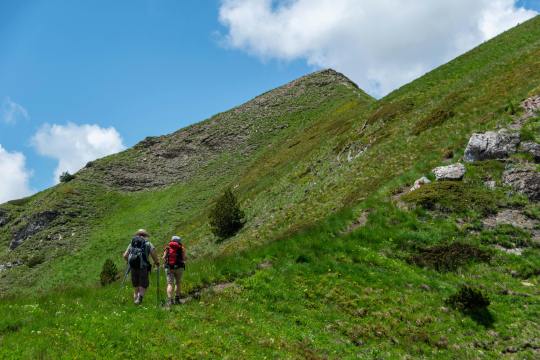
There were nearly 58 million hikers in the United States in 2023. Hiking provides individuals with numerous benefits, including improved heart health, better sleep patterns, and a lower risk for diseases, including depression. Hiking is also a great way to exercise; according to the Centers for Disease Control and Prevention, less than one in three Americans meets recommendations for physical activity. Michigan residents interested in hiking should conduct the proper research.
There is no shortage of popular hiking destinations located throughout the state. A few of the most well-known trails in Michigan include Mosquito Falls and Chapel Falls via the Chapel Loop at Rocks National Lakeshore, Penosha Trail at Brighton State Recreation Area, and the North Country National Scenic Trail in Lowell, which is roughly one-quarter of a proposed 4,600-mile trail system. At 1,250 miles, Detroit’s Iron Belle Trail will be the longest state rail in America upon completion. While these trails are popular for good reason, novice hikers should understand that these trails are busier than others.
This leads to another area of research for new hikers in Michigan: the best and worst times of year to hike. Spring and fall provide mild temperatures and beautiful foliage. Casual hikers are unlikely to venture far during the winter months when Michigan temperatures tend to stay below freezing. The summer months, meanwhile, are balmy and bring summer storms.
There are a few ways for Michigan hikers to account for the harsh weather during summer and winter. Individuals should follow weather forecasts up to the moment of departure and avoid hiking if the forecast calls for a rain or snowstorm. It is important to research regional and historical weather patterns, as certain trails may be associated with sudden lightning or flash floods. Individual hikers must set personal limits, though hiking in temperatures above 85 degrees can pose a serious health risk. Hikers should dress in layers when hiking during the winter.
Inexperienced hikers should avoid trails beyond their skill limit, regardless of conditions. The Dune Climb Trail at Dunes National Lakeshore is one of the highest-rated trails in the state. However, the 3.6-mile trek traverses loose beach sand and takes most people about 101 minutes to complete. Michigan residents should discuss their physical condition and stamina with a medical professional before taking on more advanced hiking trails. Other popular but challenging trails in Michigan include the 8.4-mile Escarpment Trail at Porcupine Mountains Wilderness State Park and the 19.2-mile Manistee River Section of the North Country Trail.
Finally, hikers should familiarize themselves with local animals and plants. Michigan is home to deadly spiders, including the brown recluse and black widow, as well as large predators, ranging from the American black bear to grey wolves. Non-predatory animals can also pose a threat to unsuspecting hikers. White-tail deer can use sharp antlers and strong hooves when provoked, while moose have earned their unfriendly reputation among humans. Hikers should thoroughly research the behavior of any animals in their region, which may also include cougars, rattlesnakes, and the toxic Fowler’s toad.
Hikers should also educate themselves on troublesome plants, which include poison ivy, poison hemlock, water hemlock, and poison sumac. Poisonous hemlock and wild parsnip are easy to overlook. Giant hogweed, fortunately, is hard to overlook: the plant can grow up to 12 feet in height. Hikers who come into contact with the giant cow parsnip become highly sensitive to ultraviolet light and experience blistering and, in some cases, permanent blindness.
1 note
·
View note
Text
Park City Through the Camera's Eye: Stunning Wildlife Photography
Nestled in the picturesque mountains of Utah, Park City is a haven for wildlife photographers. This stunning locale offers an abundance of natural beauty and diverse wildlife, making it a prime destination for capturing breathtaking images. From majestic elk and elusive mountain lions to soaring eagles and playful foxes, Park City’s varied ecosystems provide endless opportunities for photographers to capture the essence of nature.
The best time to wildlife photograph in Park City is during the early morning and late afternoon when animals are most active. The soft, golden light during these times enhances the natural beauty of the landscape and provides the perfect conditions for stunning wildlife photography. Venturing into areas like the Swaner Preserve and EcoCenter, photographers can immerse themselves in over 1,200 acres of protected land teeming with wildlife. The preserve is home to a variety of species, including deer, beavers, and numerous bird species, making it a hotspot for Wildlife Photography in Park City.
Another prime location for capturing wildlife in Park City is the Uinta-Wasatch-Cache National Forest. This expansive forest offers diverse habitats ranging from dense woodlands to alpine meadows, attracting a wide array of wildlife. Photographers can capture images of moose grazing in the meadows, black bears roaming the forests, and colorful songbirds flitting among the trees. The changing seasons also provide unique opportunities, from the vibrant fall foliage serving as a backdrop for wildlife shots to the snow-covered landscape highlighting the beauty of winter-hardy species.
For those looking to refine their skills in wildlife photography in Park City, local workshops and guided tours are available. These experiences offer valuable insights into animal behavior, best practices for ethical wildlife photography, and tips on using the right equipment to capture the perfect shot.
In conclusion, Wildlife Photography in Park City offers an unparalleled opportunity to connect with nature and capture its beauty through the lens. Whether you're an amateur photographer or a seasoned pro, the diverse wildlife and stunning landscapes of Park City provide endless inspiration for creating breathtaking images.
0 notes
Text
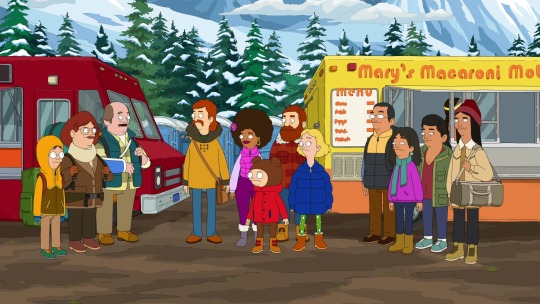
Day in Fandom History: April 30…
The citizens of Lone Moose celebrate the upcoming Rear Gifts Festival, an annual celebration of moose turds falling from the helicopter, with the Tobins, Tuntleys, and Evanoffs, by Mayor Pepper's orders, to be on their best behavior as Ham attempts to make a new friend his own age. “Rear Genius Adventure” premiered on this day, 2 Years Ago.
#Day in Fandom History#2 Years Ago#The Great North#Season 3#Episode 19#Rear Genius Adventure#Cartoon#Animation
0 notes
Text
How Big is a Moose
Moose, the majestic giants of the North American forests, have always captured the imagination of wildlife enthusiasts, photographers, and researchers alike. These towering creatures, known scientifically as Alces alces, are not just the largest members of the deer family but also one of the most fascinating wildlife species in the United States. Their impressive size, unique antlers, and intriguing behaviors make them a subject of great interest and study. Key Takeaways: - Moose are the largest species in the deer family, with males (bulls) significantly larger than females (cows). - Antler size can be a remarkable feature, with some spanning over 6 feet across. - Geographic variations affect moose size, with different subspecies adapting to specific habitats. - Understanding moose size is crucial for wildlife management and conservation efforts. Moose Size: Height and Weight When it comes to the size of a moose, the numbers are genuinely staggering. An adult male moose can stand over 6 feet tall at the shoulder, making them a towering presence in their natural habitats. Females, or cows, are slightly smaller but still command respect with their size. The weight of a moose further emphasizes their grandeur, with males averaging between 800 to 1,500 pounds and females weighing in at 600 to 1,200 pounds. These figures vary depending on the subspecies and their living conditions. Height at the Shoulder Gender Average Height Male (Bull) 6 to 7 feet Female (Cow) 5.5 to 6.5 feet Average Weight Range Gender Weight Range Male (Bull) 800 to 1,500 lbs Female (Cow) 600 to 1,200 lbs Moose Antlers: A Unique Feature One of the most distinctive features of a moose is its antlers, possessed only by the males. These are not just tools for combat and display during the mating season but also a symbol of the moose's strength and vitality. The antlers, which can grow up to an inch a day during the summer, are shed each winter and regrown the following spring, making them one of the fastest-growing animal tissues on Earth. Antler span can reach up to 6 feet from end to end, a size that is as impressive as it sounds. Antler Growth Cycle - Spring: Antlers start to regrow. - Summer: Rapid growth phase. - Fall: Antlers fully developed for the mating season. - Winter: Antlers are shed. Geographic Variations in Moose Size Not all moose are created equal, and their size can vary significantly depending on their geographic location. For instance, the Alaskan moose, one of the largest subspecies, can weigh as much as 1,600 pounds and stand over 7 feet tall at the shoulder. In contrast, the Eastern moose, found in the northeastern United States and Canada, is generally smaller, though still impressive in size. Subspecies Size Comparison Subspecies Average Weight Shoulder Height Alaskan Moose Up to 1,600 lbs Over 7 feet Eastern Moose Up to 1,200 lbs 5.5 to 6.5 feet These variations are a result of evolutionary adaptations to different environments, including differences in climate, predation pressures, and available food sources. Understanding these differences is crucial for effective wildlife management and conservation strategies. Moose are truly fascinating creatures, and their size is just one aspect of what makes them so interesting. From their towering stature to their impressive antlers, moose continue to captivate those who are lucky enough to encounter them in the wild. As we move into discussing their habitats, behaviors, and the challenges they face, it becomes clear that these giants of the forest are as complex as they are large. Moose Habitats in the United States Moose are highly adaptable creatures, thriving in a variety of habitats across the United States. They prefer colder climates and are commonly found in forested areas that offer ample vegetation for feeding. Wetlands, including lakes, rivers, and marshes, are also crucial for moose, providing them with necessary hydration and a rich source of aquatic plants that form a significant part of their diet. Preferred Moose Habitats Habitat Type Importance Forested Areas Provides shelter and diverse vegetation for feeding. Wetlands Essential for hydration and aquatic plant diet. Moose distribution in the U.S. is primarily concentrated in the Northeast, Rocky Mountains, and Alaska, each offering unique environmental conditions that cater to the moose's needs. Conservation efforts are crucial in these areas to maintain healthy moose populations and their habitats. The Role of Moose in the Ecosystem Moose play a vital role in their ecosystems as keystone species. Their feeding habits can significantly influence the composition and structure of their environment, affecting other plant and animal species. For example, their preference for certain types of vegetation can lead to changes in forest composition, which in turn impacts other wildlife. Moose Impact on Ecosystem - Vegetation Control: Moose grazing helps maintain the balance of certain plant species. - Habitat Creation: Their feeding patterns can create habitats for other wildlife. However, moose populations face challenges from climate change, predation, and human activities. These factors can lead to habitat loss and fragmentation, posing threats to moose survival and necessitating ongoing conservation efforts. Frequently Asked Questions Moose are surprisingly fast for their size, capable of running up to 35 miles per hour over short distances. This speed helps them escape predators and navigate their large habitats efficiently.Yes, moose have natural predators, including wolves and bears. However, healthy adult moose are formidable opponents, and predators often target the young, old, or sick individuals.Moose are herbivores, with a diet that includes leaves, twigs, bark, and aquatic plants. Their ability to consume a wide variety of vegetation supports their large size and nutritional needs.In the wild, moose can live up to 20 years, though their lifespan is often shorter due to predation, accidents, and diseases. Conservation efforts aim to ensure stable populations by mitigating these risks.Moose are an integral part of North America's wildlife, fascinating not only due to their size but also their ecological importance and adaptability. Understanding and preserving their habitats, addressing the challenges they face, and appreciating their role in the ecosystem are crucial for ensuring that future generations can continue to marvel at these majestic creatures. Read the full article
0 notes
Text
This Is the Most Fearsome Animal in Alaska
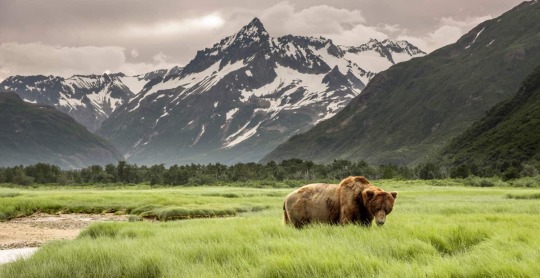
Photo Credit: Robert Frashure/Shutterstock.com
The wildlife in Alaska is Vast and Varied. Known as the “Last Frontier State,” it is one of the few places in the United States with large, untouched natural landscapes. While most outsiders think of endless snow and glaciers in this polar region, the state is home to two of the United States’ most extensive forests, which provide habitat for nearly 1,100 Vertebrate Species. In fact, Alaska’s designated wilderness acreage constitutes approximately 54 percent of the nation’s—making habitat for a vast diversity of species surviving in harsh conditions. Many of which can be particularly fearsome.
But Which Animal in Alaska is the Most Deadly to Humans?
Moose, who are generally regarded as docile herbivores, injure around 5-10 people annually. Polar bears, whose girth during mating season can reach about 1700 pounds, are a deadly opponent on the icy tundra. Even the smaller gray wolf can become a lethal killing machine. These carnivores can take down a massive moose or bear in packs and organize into reconnaissance groups that canvass territory over 2,300 square miles.
However, if you find yourself in the Alaskan wilderness, there is one animal above all others you don’t want to cross paths with. And that’s the fierce and lethal Grizzly Bear.
Grizzly Bear
Alaska has an estimated 30,000 Grizzlies, the highest in any region of the U.S. Luckily for most visitors, the areas these bears habitat are usually far away from where humans live. Additionally, there are only a few seasons when grizzly bears are active and dangerous. However, when camping or hiking, it’s important to know your surroundings and bear behaviors. A few simple tools can save your life when encountering one of the most deadly animals in Alaska.
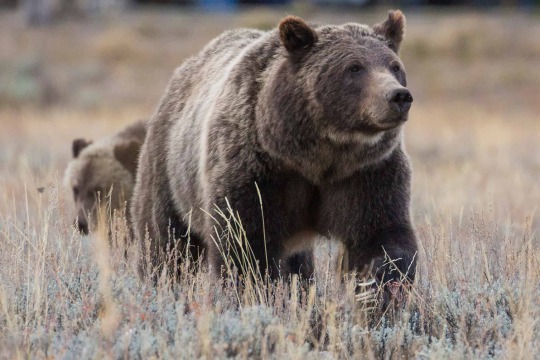
Grizzly bears are most active in the fall and spring and are one of the most deadly animals in Alaska. ©BlueBarronPhoto/Shutterstock.com
The grizzly bear is actually a type of brown bear. Coastal Grizzly Bears, Kodiak Bears, and the Asian Grizzly are considered to be the same subspecies. They range in color from very light tan to dark brown. The coloration gives them a “grizzled” look, especially in the sun. Additionally, they have a rounder face shape, short ears, and a large hump on their shoulder. This hump creates mass on the bear, making it much larger and more robust than black bears.
They can weigh up to 700 Pounds (the same as a 20-foot Sailboat!), and in their native habitat, are often unafraid of humans (unlike black bears). This behavior often makes them one of the most deadly animals in Alaska.
According to the Alaskan Department of Natural Resources, the one thing you can predict about a grizzly bear is that it’s unpredictable. However, biologists have recently reduced confrontations thanks to a newly developed understanding of bear behavior. Mainly, it’s essential to respect the bears and where they live.
The worst incidents between bears and people occur when people misbehave toward them.
“I’ve seen people do stupid things to bears,” said John Hechtel, an Alaska Department of Fish and Game biologist. “I’ve seen people throw rocks at a grazing bear from 2 feet away just to get a better picture.”
Hechtel suggested that 95 percent of the time, people determine whether the outcome of a bear encounter will be good or bad.
The fall and spring are when the bears are most active. If you accidentally encounter a grizzly bear during this time, you can do a few things to ensure your meeting ends well.
What You Should Do To Protect Yourself From Grizzly Bears:
Above all else, avoid the bears if you can by being aware of your surroundings. Trailheads often post signs about bear activity. When in an area designated as “bear heavy,” look for tracks along the road and make plenty of noise so you don’t surprise one. Lastly, always travel in groups or with another person. Never go alone.
Although, don’t bring your dog, either.
Often, unwelcome incidents between wild animals and humans result from aggression between your pet and the animals. Humans get hurt when they intercede between their dogs and the animals. A dog’s instinct to protect their owner or curiosity between the bears and dogs has often escalated and become hazardous.
When camping, never leave food or garbage out. Use bear-proof cans or lockers when storing or throwing away leftovers. Odors attract bears, so be sure your camp is as clean and odor-free as possible.
Additionally, don’t camp near areas where bears are. This includes near a trail, salmon streams, dead animals, or old fire pits (which may have leftover food). Choose a spot where you can see wildlife, and they can easily see you. This can help you avoid one of the most deadly animals in Alaska.
When cooking, make sure you’re at least 100 feet away from your campsite. Cook downwind and store your pots and pans away from you. Cache the food you want in a tree and out of reach of any potential predators.
According to the National Park Service, this is what you should do if you encounter a bear:
If you see a grizzly bear and it hasn’t seen you—walk away. However, if the bear is close and notices you, it’s important to try to stay calm. Not disturbing the bear reduces attacks. Often, it helps to wave your arms and speak in a loud but low voice. While you should back away slowly if it starts approaching, it’s important NOT TO RUN.
A bluff charge may occur during your encounter. Almost all charges are bluffs. It’s important to stand your ground, as running will encourage it to chase you. Outrunning a bear is futile.
If you’re attacked, playing dead works. Curl up in a ball with your hands laced behind your neck. The fetal position will protect your vital organs. A surprised bear will grow disinterested.
Any attack resulting from a bear stalking or pursuing you, you’ll need to fight back. Predatory bears are often intimidated into leaving you alone. In these cases, carrying a weapon, such as bear spray or a knife, is best. However, almost all bear attacks can be avoided without violence. Just use common sense. Continuously reducing the probability of bear encounters is your best protection when dealing with one of the most deadly animals in Alaska.
#Aninimal#Article#Most Fearsome#Alaska | USA 🇺🇸#Grizzly Bears | Kodiak Bears | Asian Grizzly#Black Bears#AZ Animals#Monday November 20 | 2023
1 note
·
View note